Analysis of International Trade and Logistics for Australia's Economy
VerifiedAdded on 2022/11/13
|13
|2296
|56
Report
AI Summary
This report analyzes international trade and logistics, focusing on Australia's role in the global market. It begins with an executive summary outlining key findings from a simulated trading exercise, where the author, representing an Australian trader, buys and sells commodities like aluminum, wool, and coal. The report explores the benefits and challenges of both free trade and anti-trade environments for Australia, including increased market access, income, and production versus fewer markets, higher costs, and reduced domestic spending. Comparisons are made between value creation in free trade and value destruction in anti-trade scenarios. The conclusion emphasizes the advantages of free trade. Finally, the report offers policy recommendations for Australia, such as strengthening its brand, expanding its export portfolio, and lowering the costs of international business. The report also includes appendices with Gantt charts for sales and purchases, and references to relevant literature.
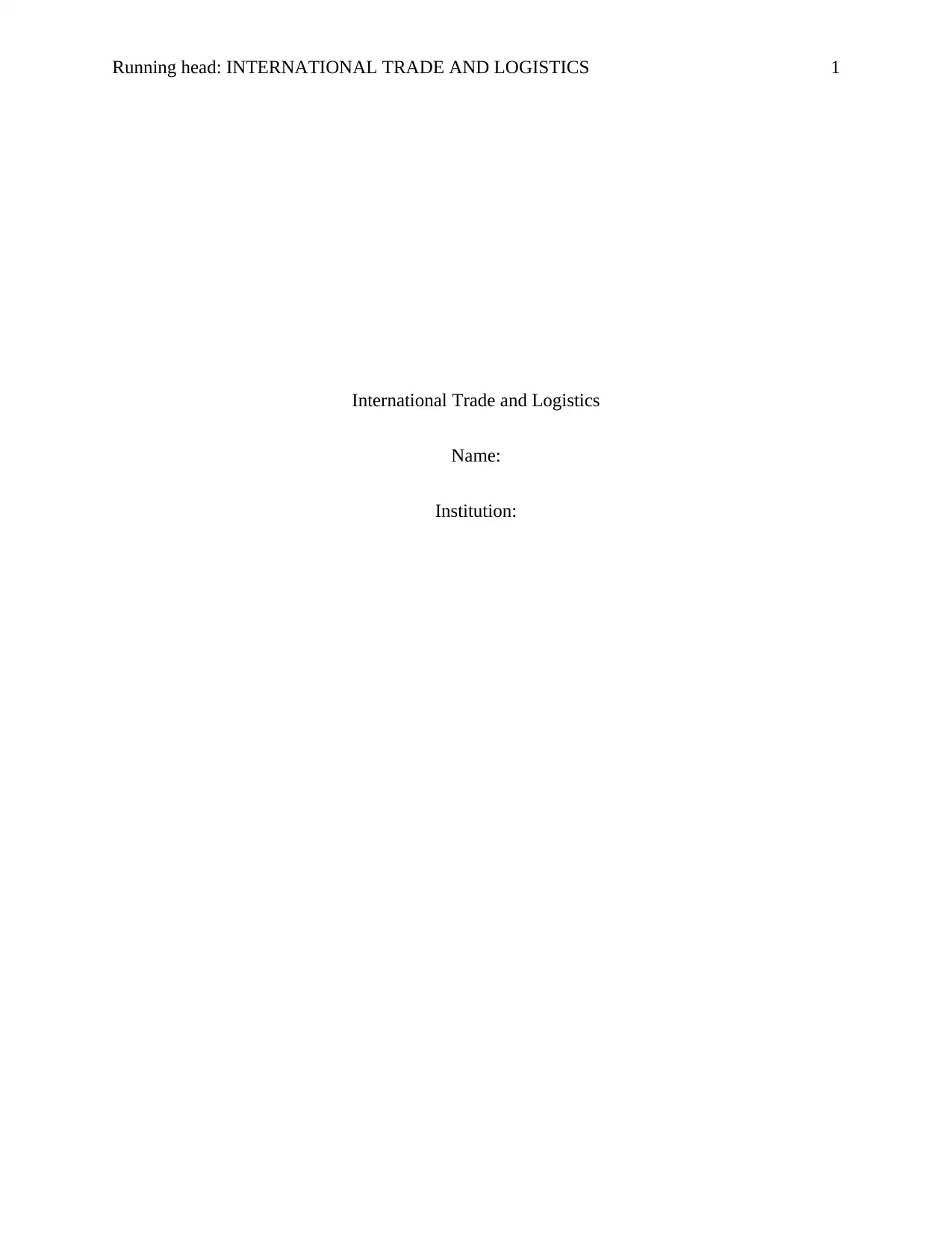
Running head: INTERNATIONAL TRADE AND LOGISTICS 1
International Trade and Logistics
Name:
Institution:
International Trade and Logistics
Name:
Institution:
Paraphrase This Document
Need a fresh take? Get an instant paraphrase of this document with our AI Paraphraser
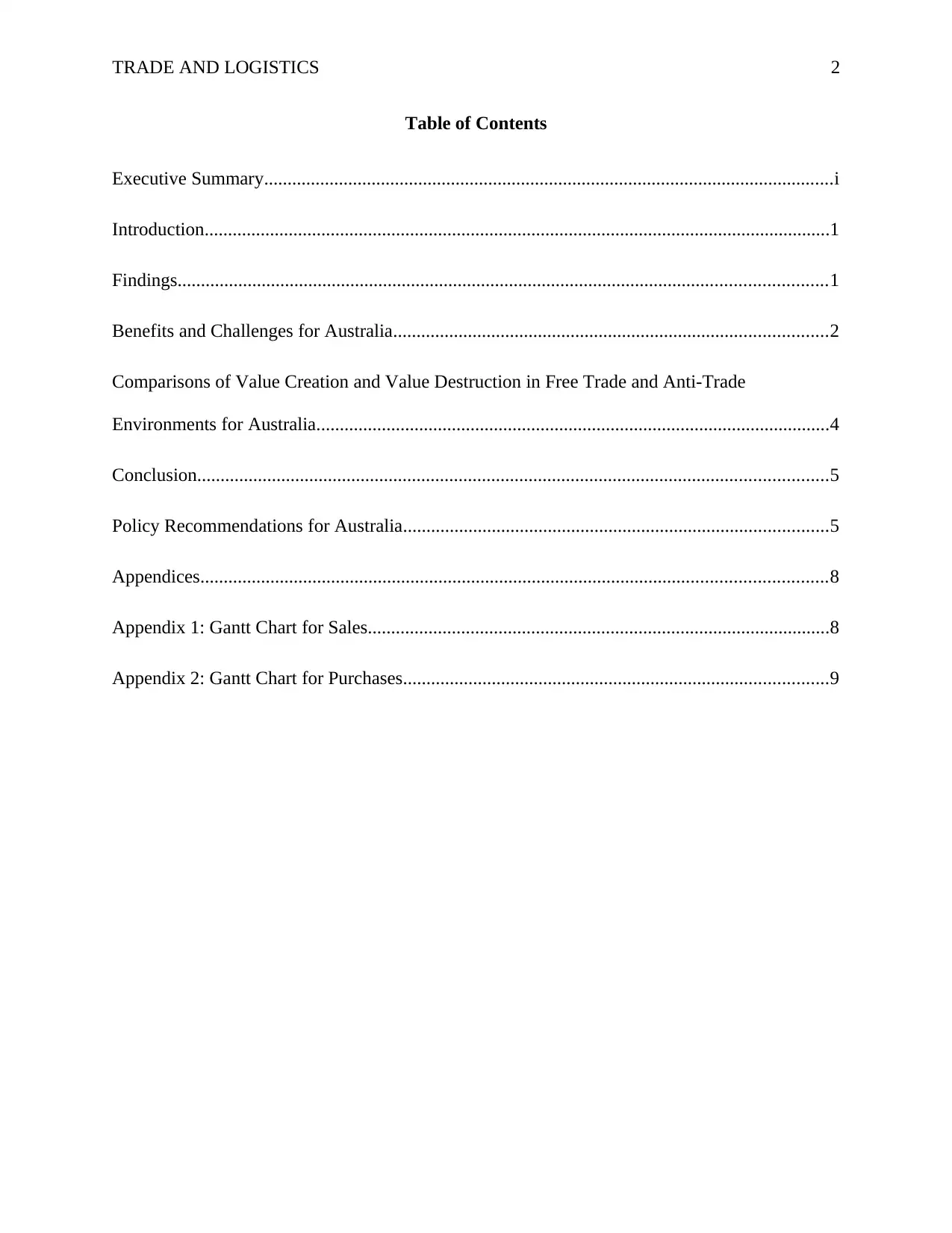
TRADE AND LOGISTICS 2
Table of Contents
Executive Summary..........................................................................................................................i
Introduction......................................................................................................................................1
Findings...........................................................................................................................................1
Benefits and Challenges for Australia.............................................................................................2
Comparisons of Value Creation and Value Destruction in Free Trade and Anti-Trade
Environments for Australia..............................................................................................................4
Conclusion.......................................................................................................................................5
Policy Recommendations for Australia...........................................................................................5
Appendices......................................................................................................................................8
Appendix 1: Gantt Chart for Sales...................................................................................................8
Appendix 2: Gantt Chart for Purchases...........................................................................................9
Table of Contents
Executive Summary..........................................................................................................................i
Introduction......................................................................................................................................1
Findings...........................................................................................................................................1
Benefits and Challenges for Australia.............................................................................................2
Comparisons of Value Creation and Value Destruction in Free Trade and Anti-Trade
Environments for Australia..............................................................................................................4
Conclusion.......................................................................................................................................5
Policy Recommendations for Australia...........................................................................................5
Appendices......................................................................................................................................8
Appendix 1: Gantt Chart for Sales...................................................................................................8
Appendix 2: Gantt Chart for Purchases...........................................................................................9
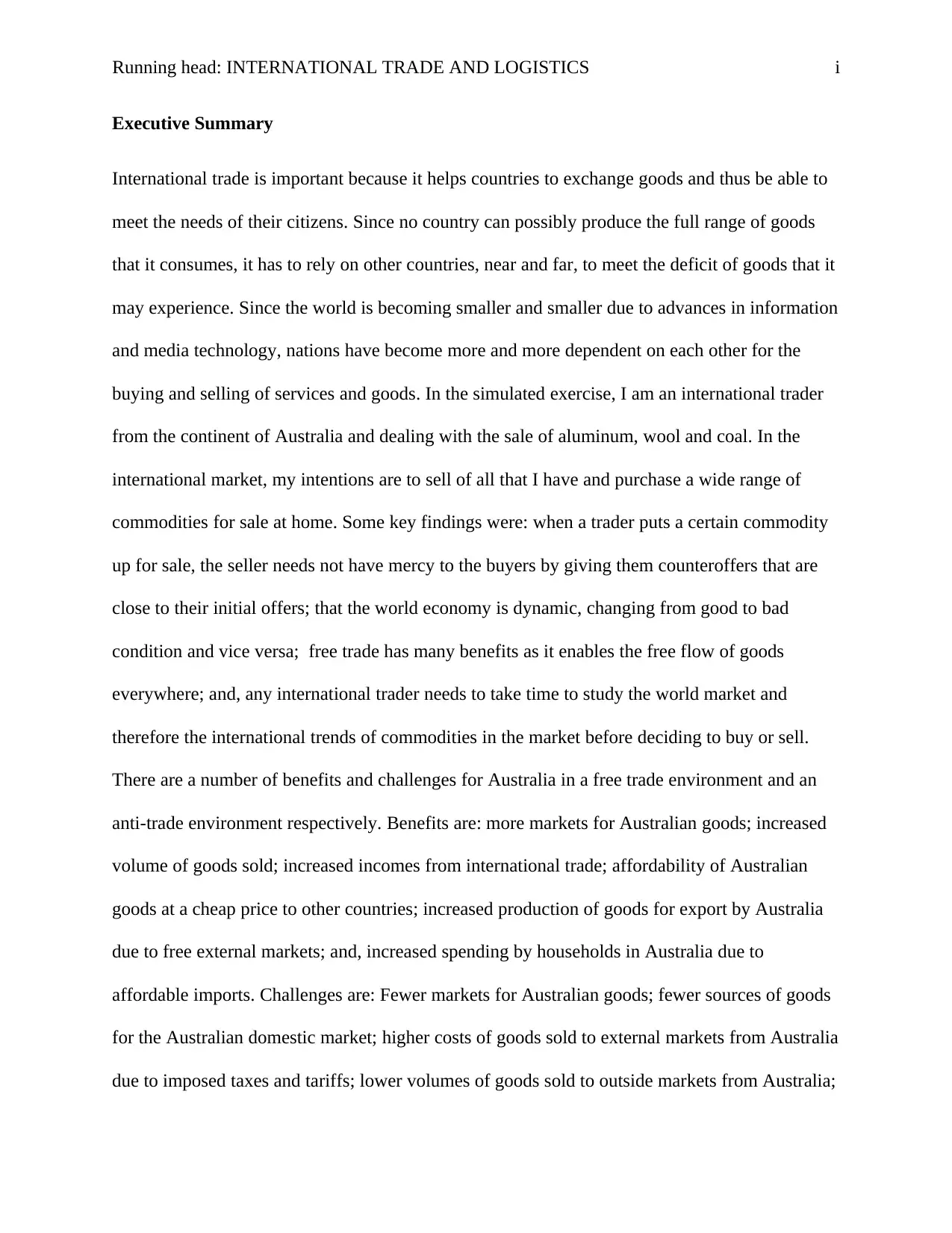
Running head: INTERNATIONAL TRADE AND LOGISTICS i
Executive Summary
International trade is important because it helps countries to exchange goods and thus be able to
meet the needs of their citizens. Since no country can possibly produce the full range of goods
that it consumes, it has to rely on other countries, near and far, to meet the deficit of goods that it
may experience. Since the world is becoming smaller and smaller due to advances in information
and media technology, nations have become more and more dependent on each other for the
buying and selling of services and goods. In the simulated exercise, I am an international trader
from the continent of Australia and dealing with the sale of aluminum, wool and coal. In the
international market, my intentions are to sell of all that I have and purchase a wide range of
commodities for sale at home. Some key findings were: when a trader puts a certain commodity
up for sale, the seller needs not have mercy to the buyers by giving them counteroffers that are
close to their initial offers; that the world economy is dynamic, changing from good to bad
condition and vice versa; free trade has many benefits as it enables the free flow of goods
everywhere; and, any international trader needs to take time to study the world market and
therefore the international trends of commodities in the market before deciding to buy or sell.
There are a number of benefits and challenges for Australia in a free trade environment and an
anti-trade environment respectively. Benefits are: more markets for Australian goods; increased
volume of goods sold; increased incomes from international trade; affordability of Australian
goods at a cheap price to other countries; increased production of goods for export by Australia
due to free external markets; and, increased spending by households in Australia due to
affordable imports. Challenges are: Fewer markets for Australian goods; fewer sources of goods
for the Australian domestic market; higher costs of goods sold to external markets from Australia
due to imposed taxes and tariffs; lower volumes of goods sold to outside markets from Australia;
Executive Summary
International trade is important because it helps countries to exchange goods and thus be able to
meet the needs of their citizens. Since no country can possibly produce the full range of goods
that it consumes, it has to rely on other countries, near and far, to meet the deficit of goods that it
may experience. Since the world is becoming smaller and smaller due to advances in information
and media technology, nations have become more and more dependent on each other for the
buying and selling of services and goods. In the simulated exercise, I am an international trader
from the continent of Australia and dealing with the sale of aluminum, wool and coal. In the
international market, my intentions are to sell of all that I have and purchase a wide range of
commodities for sale at home. Some key findings were: when a trader puts a certain commodity
up for sale, the seller needs not have mercy to the buyers by giving them counteroffers that are
close to their initial offers; that the world economy is dynamic, changing from good to bad
condition and vice versa; free trade has many benefits as it enables the free flow of goods
everywhere; and, any international trader needs to take time to study the world market and
therefore the international trends of commodities in the market before deciding to buy or sell.
There are a number of benefits and challenges for Australia in a free trade environment and an
anti-trade environment respectively. Benefits are: more markets for Australian goods; increased
volume of goods sold; increased incomes from international trade; affordability of Australian
goods at a cheap price to other countries; increased production of goods for export by Australia
due to free external markets; and, increased spending by households in Australia due to
affordable imports. Challenges are: Fewer markets for Australian goods; fewer sources of goods
for the Australian domestic market; higher costs of goods sold to external markets from Australia
due to imposed taxes and tariffs; lower volumes of goods sold to outside markets from Australia;
You're viewing a preview
Unlock full access by subscribing today!
Enjoy unlimited downloads | Full document access |
Advanced AI study tools
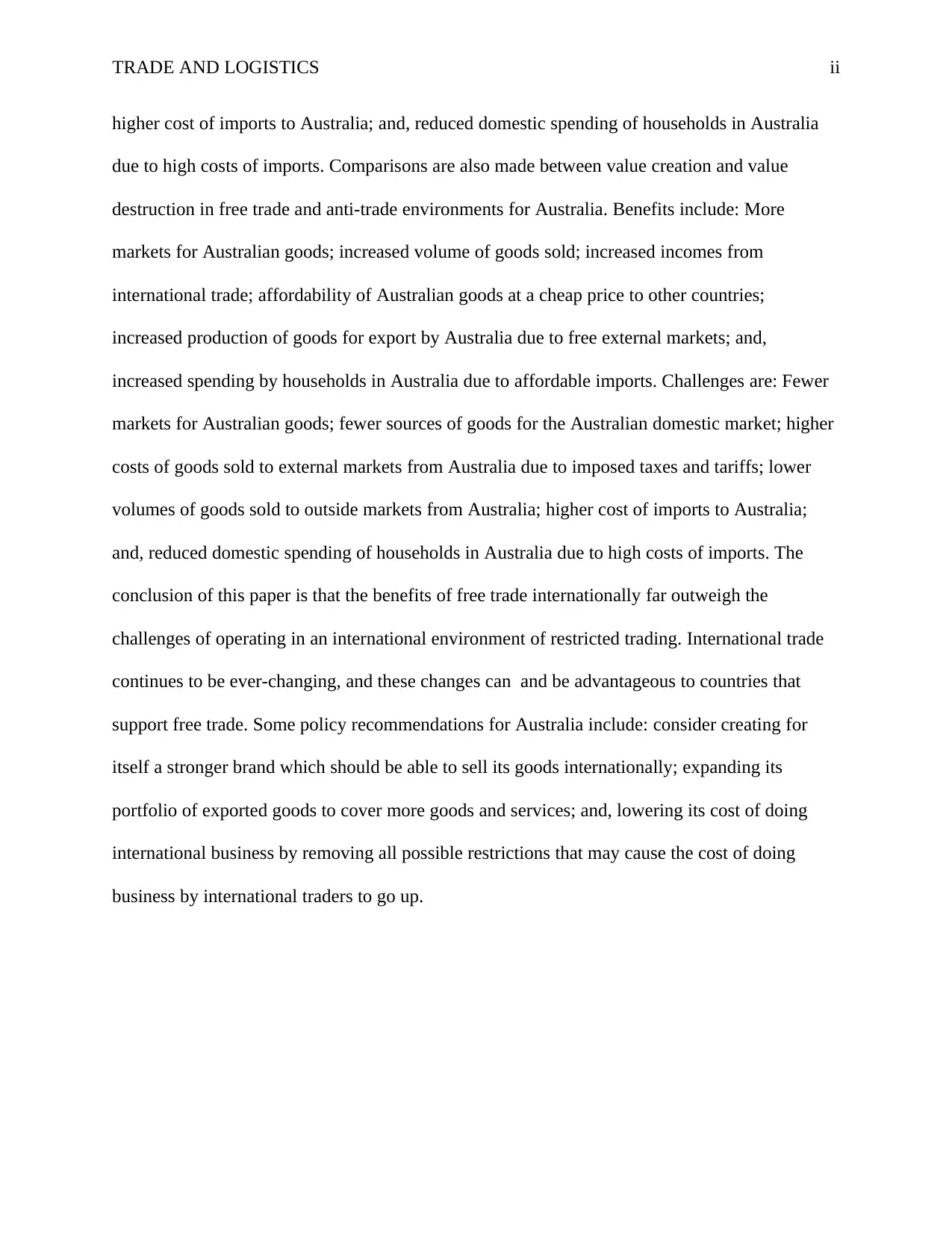
TRADE AND LOGISTICS ii
higher cost of imports to Australia; and, reduced domestic spending of households in Australia
due to high costs of imports. Comparisons are also made between value creation and value
destruction in free trade and anti-trade environments for Australia. Benefits include: More
markets for Australian goods; increased volume of goods sold; increased incomes from
international trade; affordability of Australian goods at a cheap price to other countries;
increased production of goods for export by Australia due to free external markets; and,
increased spending by households in Australia due to affordable imports. Challenges are: Fewer
markets for Australian goods; fewer sources of goods for the Australian domestic market; higher
costs of goods sold to external markets from Australia due to imposed taxes and tariffs; lower
volumes of goods sold to outside markets from Australia; higher cost of imports to Australia;
and, reduced domestic spending of households in Australia due to high costs of imports. The
conclusion of this paper is that the benefits of free trade internationally far outweigh the
challenges of operating in an international environment of restricted trading. International trade
continues to be ever-changing, and these changes can and be advantageous to countries that
support free trade. Some policy recommendations for Australia include: consider creating for
itself a stronger brand which should be able to sell its goods internationally; expanding its
portfolio of exported goods to cover more goods and services; and, lowering its cost of doing
international business by removing all possible restrictions that may cause the cost of doing
business by international traders to go up.
higher cost of imports to Australia; and, reduced domestic spending of households in Australia
due to high costs of imports. Comparisons are also made between value creation and value
destruction in free trade and anti-trade environments for Australia. Benefits include: More
markets for Australian goods; increased volume of goods sold; increased incomes from
international trade; affordability of Australian goods at a cheap price to other countries;
increased production of goods for export by Australia due to free external markets; and,
increased spending by households in Australia due to affordable imports. Challenges are: Fewer
markets for Australian goods; fewer sources of goods for the Australian domestic market; higher
costs of goods sold to external markets from Australia due to imposed taxes and tariffs; lower
volumes of goods sold to outside markets from Australia; higher cost of imports to Australia;
and, reduced domestic spending of households in Australia due to high costs of imports. The
conclusion of this paper is that the benefits of free trade internationally far outweigh the
challenges of operating in an international environment of restricted trading. International trade
continues to be ever-changing, and these changes can and be advantageous to countries that
support free trade. Some policy recommendations for Australia include: consider creating for
itself a stronger brand which should be able to sell its goods internationally; expanding its
portfolio of exported goods to cover more goods and services; and, lowering its cost of doing
international business by removing all possible restrictions that may cause the cost of doing
business by international traders to go up.
Paraphrase This Document
Need a fresh take? Get an instant paraphrase of this document with our AI Paraphraser
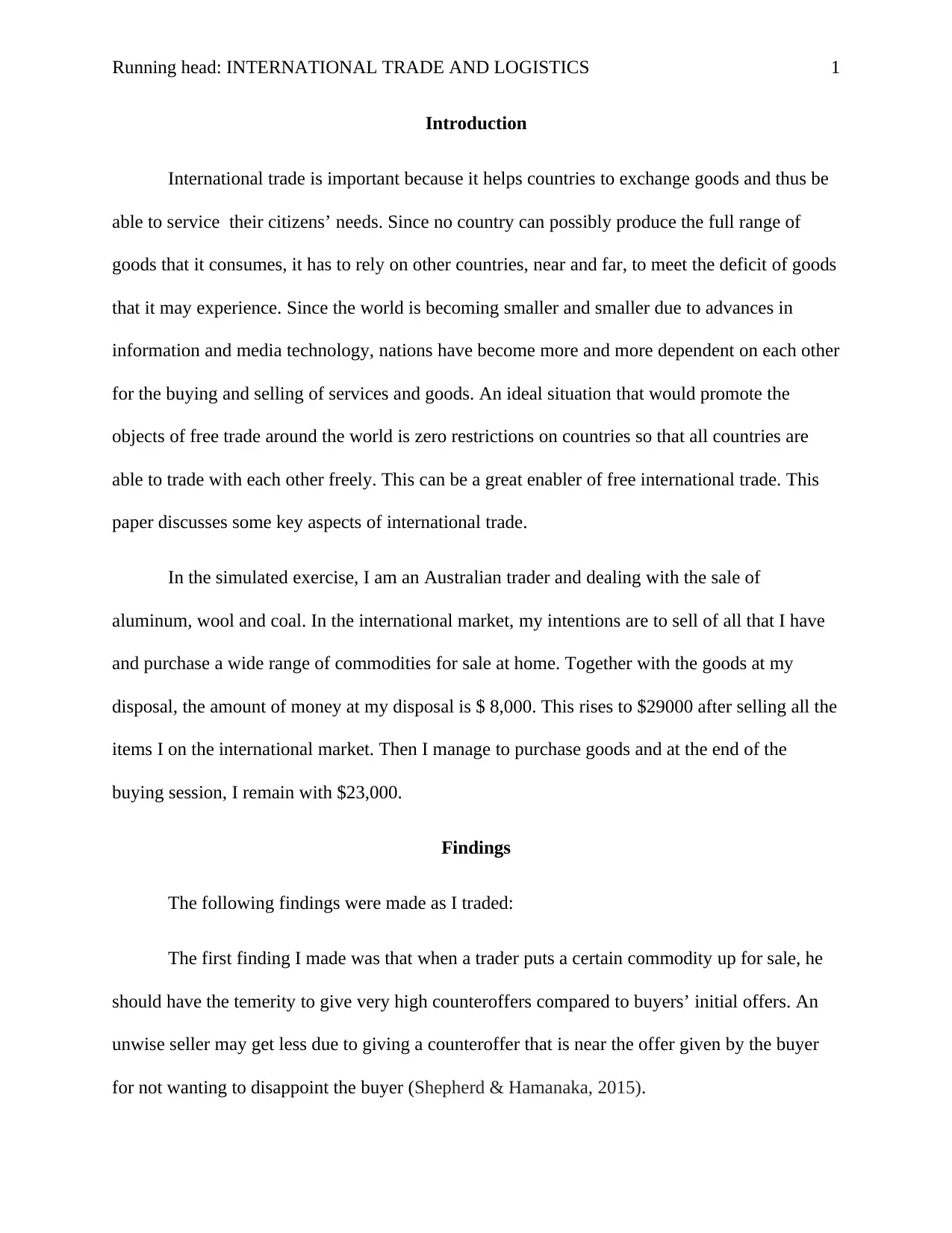
Running head: INTERNATIONAL TRADE AND LOGISTICS 1
Introduction
International trade is important because it helps countries to exchange goods and thus be
able to service their citizens’ needs. Since no country can possibly produce the full range of
goods that it consumes, it has to rely on other countries, near and far, to meet the deficit of goods
that it may experience. Since the world is becoming smaller and smaller due to advances in
information and media technology, nations have become more and more dependent on each other
for the buying and selling of services and goods. An ideal situation that would promote the
objects of free trade around the world is zero restrictions on countries so that all countries are
able to trade with each other freely. This can be a great enabler of free international trade. This
paper discusses some key aspects of international trade.
In the simulated exercise, I am an Australian trader and dealing with the sale of
aluminum, wool and coal. In the international market, my intentions are to sell of all that I have
and purchase a wide range of commodities for sale at home. Together with the goods at my
disposal, the amount of money at my disposal is $ 8,000. This rises to $29000 after selling all the
items I on the international market. Then I manage to purchase goods and at the end of the
buying session, I remain with $23,000.
Findings
The following findings were made as I traded:
The first finding I made was that when a trader puts a certain commodity up for sale, he
should have the temerity to give very high counteroffers compared to buyers’ initial offers. An
unwise seller may get less due to giving a counteroffer that is near the offer given by the buyer
for not wanting to disappoint the buyer (Shepherd & Hamanaka, 2015).
Introduction
International trade is important because it helps countries to exchange goods and thus be
able to service their citizens’ needs. Since no country can possibly produce the full range of
goods that it consumes, it has to rely on other countries, near and far, to meet the deficit of goods
that it may experience. Since the world is becoming smaller and smaller due to advances in
information and media technology, nations have become more and more dependent on each other
for the buying and selling of services and goods. An ideal situation that would promote the
objects of free trade around the world is zero restrictions on countries so that all countries are
able to trade with each other freely. This can be a great enabler of free international trade. This
paper discusses some key aspects of international trade.
In the simulated exercise, I am an Australian trader and dealing with the sale of
aluminum, wool and coal. In the international market, my intentions are to sell of all that I have
and purchase a wide range of commodities for sale at home. Together with the goods at my
disposal, the amount of money at my disposal is $ 8,000. This rises to $29000 after selling all the
items I on the international market. Then I manage to purchase goods and at the end of the
buying session, I remain with $23,000.
Findings
The following findings were made as I traded:
The first finding I made was that when a trader puts a certain commodity up for sale, he
should have the temerity to give very high counteroffers compared to buyers’ initial offers. An
unwise seller may get less due to giving a counteroffer that is near the offer given by the buyer
for not wanting to disappoint the buyer (Shepherd & Hamanaka, 2015).
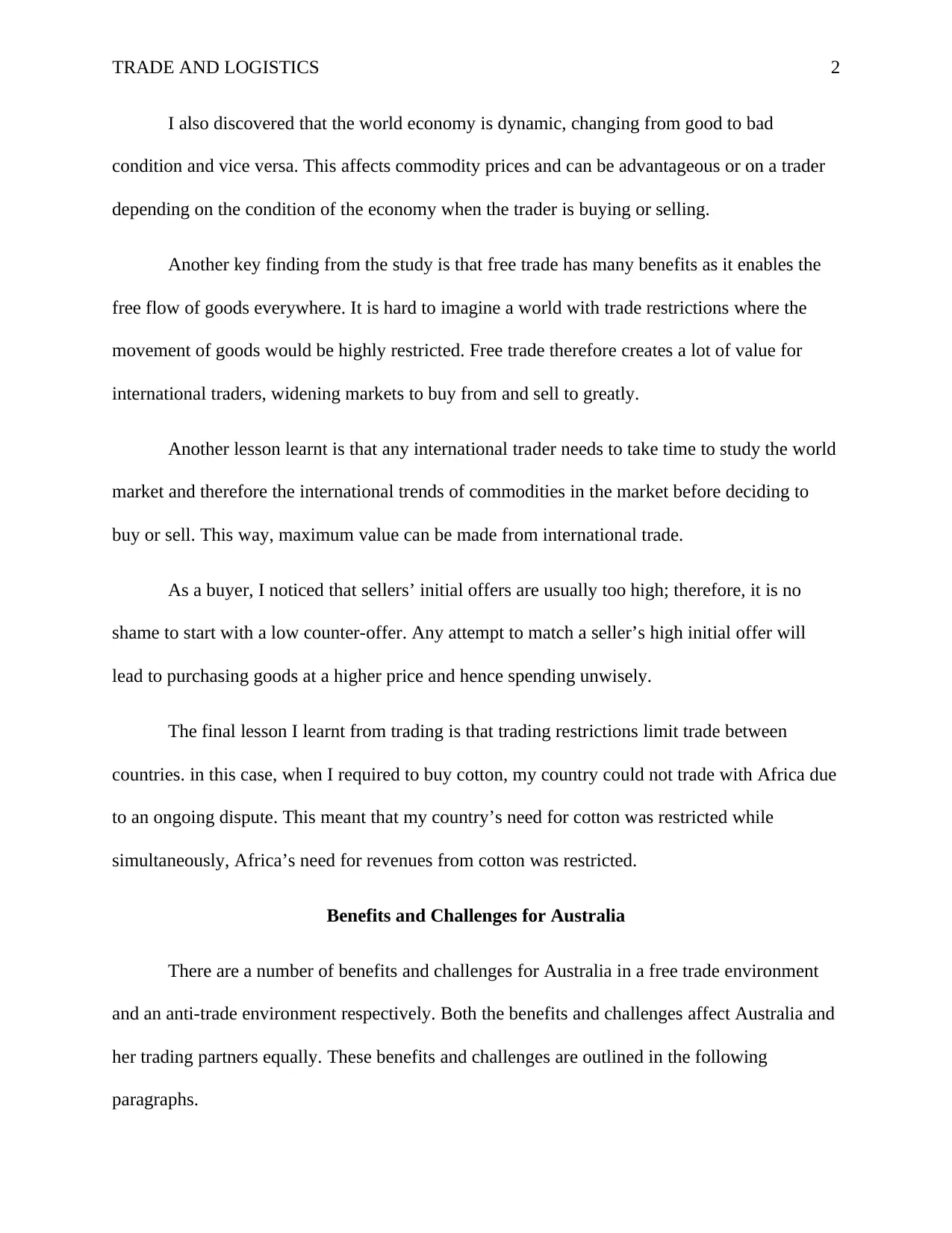
TRADE AND LOGISTICS 2
I also discovered that the world economy is dynamic, changing from good to bad
condition and vice versa. This affects commodity prices and can be advantageous or on a trader
depending on the condition of the economy when the trader is buying or selling.
Another key finding from the study is that free trade has many benefits as it enables the
free flow of goods everywhere. It is hard to imagine a world with trade restrictions where the
movement of goods would be highly restricted. Free trade therefore creates a lot of value for
international traders, widening markets to buy from and sell to greatly.
Another lesson learnt is that any international trader needs to take time to study the world
market and therefore the international trends of commodities in the market before deciding to
buy or sell. This way, maximum value can be made from international trade.
As a buyer, I noticed that sellers’ initial offers are usually too high; therefore, it is no
shame to start with a low counter-offer. Any attempt to match a seller’s high initial offer will
lead to purchasing goods at a higher price and hence spending unwisely.
The final lesson I learnt from trading is that trading restrictions limit trade between
countries. in this case, when I required to buy cotton, my country could not trade with Africa due
to an ongoing dispute. This meant that my country’s need for cotton was restricted while
simultaneously, Africa’s need for revenues from cotton was restricted.
Benefits and Challenges for Australia
There are a number of benefits and challenges for Australia in a free trade environment
and an anti-trade environment respectively. Both the benefits and challenges affect Australia and
her trading partners equally. These benefits and challenges are outlined in the following
paragraphs.
I also discovered that the world economy is dynamic, changing from good to bad
condition and vice versa. This affects commodity prices and can be advantageous or on a trader
depending on the condition of the economy when the trader is buying or selling.
Another key finding from the study is that free trade has many benefits as it enables the
free flow of goods everywhere. It is hard to imagine a world with trade restrictions where the
movement of goods would be highly restricted. Free trade therefore creates a lot of value for
international traders, widening markets to buy from and sell to greatly.
Another lesson learnt is that any international trader needs to take time to study the world
market and therefore the international trends of commodities in the market before deciding to
buy or sell. This way, maximum value can be made from international trade.
As a buyer, I noticed that sellers’ initial offers are usually too high; therefore, it is no
shame to start with a low counter-offer. Any attempt to match a seller’s high initial offer will
lead to purchasing goods at a higher price and hence spending unwisely.
The final lesson I learnt from trading is that trading restrictions limit trade between
countries. in this case, when I required to buy cotton, my country could not trade with Africa due
to an ongoing dispute. This meant that my country’s need for cotton was restricted while
simultaneously, Africa’s need for revenues from cotton was restricted.
Benefits and Challenges for Australia
There are a number of benefits and challenges for Australia in a free trade environment
and an anti-trade environment respectively. Both the benefits and challenges affect Australia and
her trading partners equally. These benefits and challenges are outlined in the following
paragraphs.
You're viewing a preview
Unlock full access by subscribing today!
Enjoy unlimited downloads | Full document access |
Advanced AI study tools
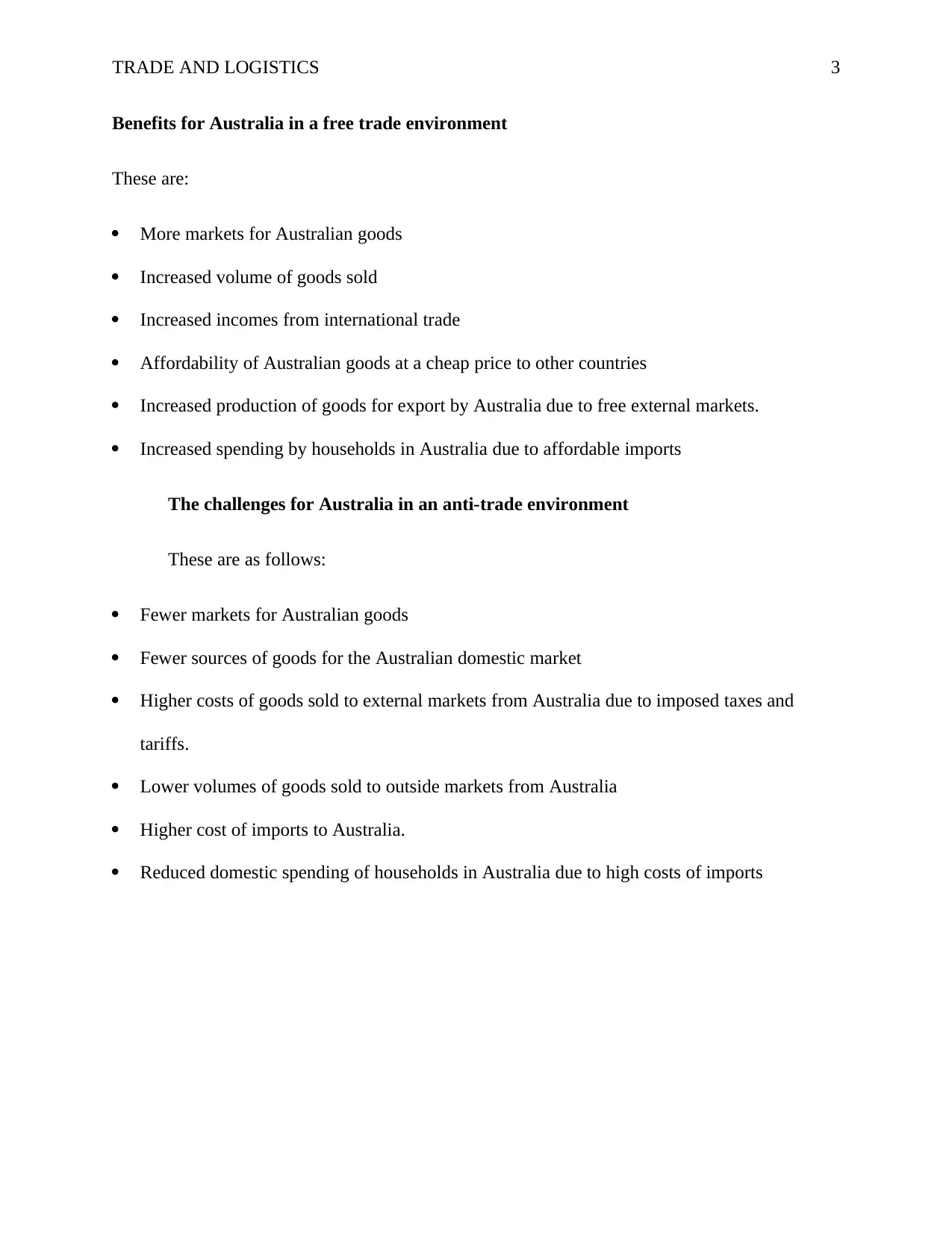
TRADE AND LOGISTICS 3
Benefits for Australia in a free trade environment
These are:
More markets for Australian goods
Increased volume of goods sold
Increased incomes from international trade
Affordability of Australian goods at a cheap price to other countries
Increased production of goods for export by Australia due to free external markets.
Increased spending by households in Australia due to affordable imports
The challenges for Australia in an anti-trade environment
These are as follows:
Fewer markets for Australian goods
Fewer sources of goods for the Australian domestic market
Higher costs of goods sold to external markets from Australia due to imposed taxes and
tariffs.
Lower volumes of goods sold to outside markets from Australia
Higher cost of imports to Australia.
Reduced domestic spending of households in Australia due to high costs of imports
Benefits for Australia in a free trade environment
These are:
More markets for Australian goods
Increased volume of goods sold
Increased incomes from international trade
Affordability of Australian goods at a cheap price to other countries
Increased production of goods for export by Australia due to free external markets.
Increased spending by households in Australia due to affordable imports
The challenges for Australia in an anti-trade environment
These are as follows:
Fewer markets for Australian goods
Fewer sources of goods for the Australian domestic market
Higher costs of goods sold to external markets from Australia due to imposed taxes and
tariffs.
Lower volumes of goods sold to outside markets from Australia
Higher cost of imports to Australia.
Reduced domestic spending of households in Australia due to high costs of imports
Paraphrase This Document
Need a fresh take? Get an instant paraphrase of this document with our AI Paraphraser
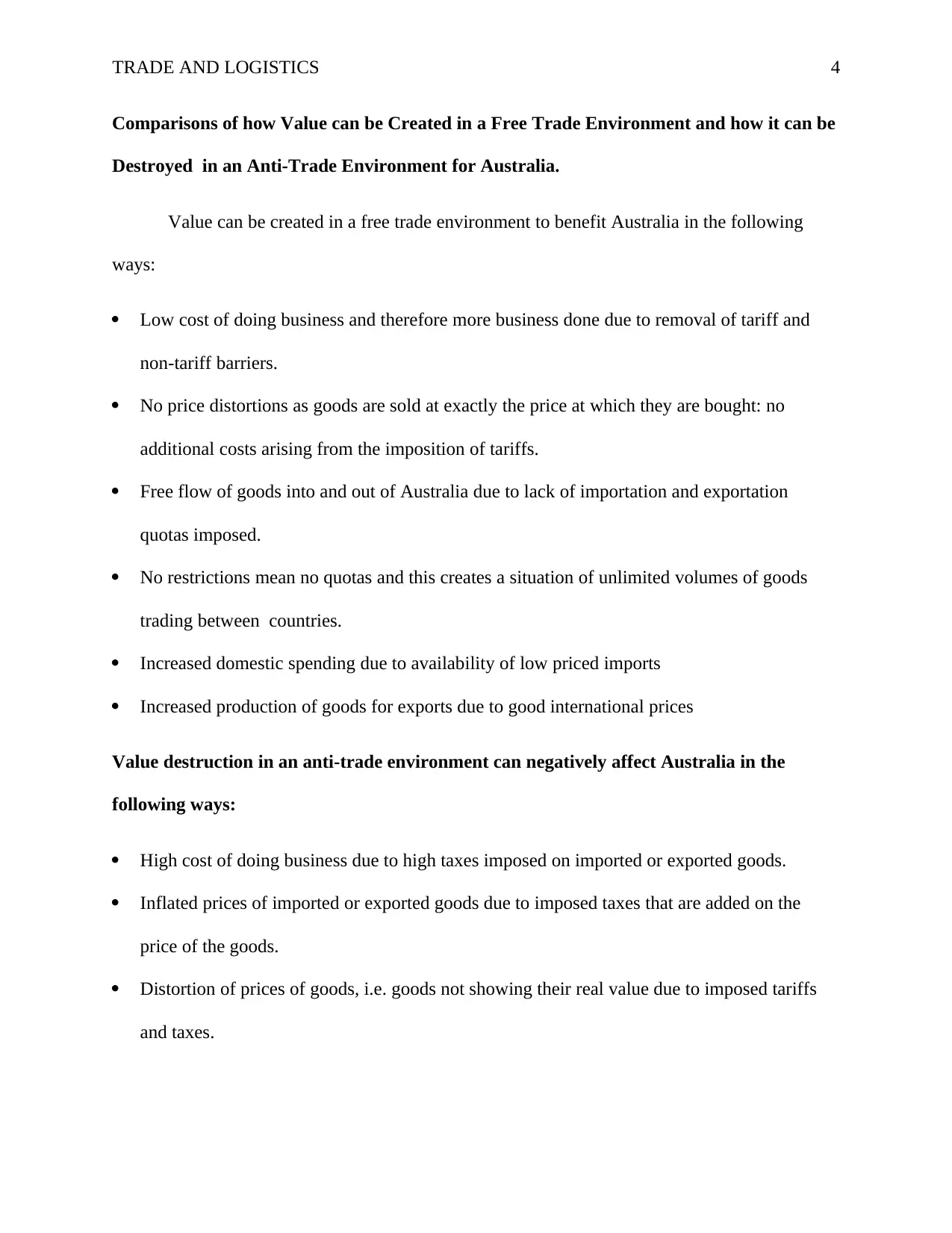
TRADE AND LOGISTICS 4
Comparisons of how Value can be Created in a Free Trade Environment and how it can be
Destroyed in an Anti-Trade Environment for Australia.
Value can be created in a free trade environment to benefit Australia in the following
ways:
Low cost of doing business and therefore more business done due to removal of tariff and
non-tariff barriers.
No price distortions as goods are sold at exactly the price at which they are bought: no
additional costs arising from the imposition of tariffs.
Free flow of goods into and out of Australia due to lack of importation and exportation
quotas imposed.
No restrictions mean no quotas and this creates a situation of unlimited volumes of goods
trading between countries.
Increased domestic spending due to availability of low priced imports
Increased production of goods for exports due to good international prices
Value destruction in an anti-trade environment can negatively affect Australia in the
following ways:
High cost of doing business due to high taxes imposed on imported or exported goods.
Inflated prices of imported or exported goods due to imposed taxes that are added on the
price of the goods.
Distortion of prices of goods, i.e. goods not showing their real value due to imposed tariffs
and taxes.
Comparisons of how Value can be Created in a Free Trade Environment and how it can be
Destroyed in an Anti-Trade Environment for Australia.
Value can be created in a free trade environment to benefit Australia in the following
ways:
Low cost of doing business and therefore more business done due to removal of tariff and
non-tariff barriers.
No price distortions as goods are sold at exactly the price at which they are bought: no
additional costs arising from the imposition of tariffs.
Free flow of goods into and out of Australia due to lack of importation and exportation
quotas imposed.
No restrictions mean no quotas and this creates a situation of unlimited volumes of goods
trading between countries.
Increased domestic spending due to availability of low priced imports
Increased production of goods for exports due to good international prices
Value destruction in an anti-trade environment can negatively affect Australia in the
following ways:
High cost of doing business due to high taxes imposed on imported or exported goods.
Inflated prices of imported or exported goods due to imposed taxes that are added on the
price of the goods.
Distortion of prices of goods, i.e. goods not showing their real value due to imposed tariffs
and taxes.
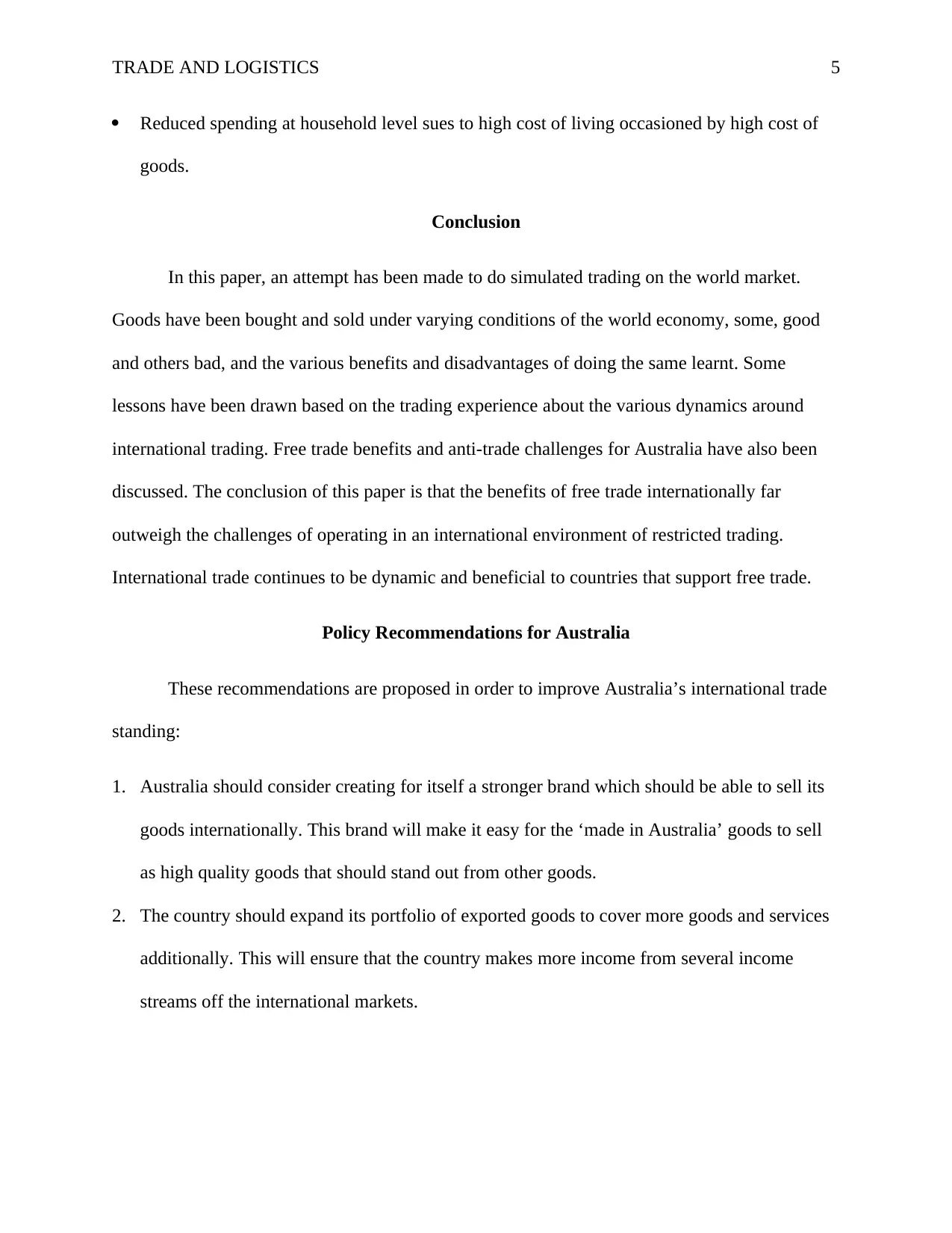
TRADE AND LOGISTICS 5
Reduced spending at household level sues to high cost of living occasioned by high cost of
goods.
Conclusion
In this paper, an attempt has been made to do simulated trading on the world market.
Goods have been bought and sold under varying conditions of the world economy, some, good
and others bad, and the various benefits and disadvantages of doing the same learnt. Some
lessons have been drawn based on the trading experience about the various dynamics around
international trading. Free trade benefits and anti-trade challenges for Australia have also been
discussed. The conclusion of this paper is that the benefits of free trade internationally far
outweigh the challenges of operating in an international environment of restricted trading.
International trade continues to be dynamic and beneficial to countries that support free trade.
Policy Recommendations for Australia
These recommendations are proposed in order to improve Australia’s international trade
standing:
1. Australia should consider creating for itself a stronger brand which should be able to sell its
goods internationally. This brand will make it easy for the ‘made in Australia’ goods to sell
as high quality goods that should stand out from other goods.
2. The country should expand its portfolio of exported goods to cover more goods and services
additionally. This will ensure that the country makes more income from several income
streams off the international markets.
Reduced spending at household level sues to high cost of living occasioned by high cost of
goods.
Conclusion
In this paper, an attempt has been made to do simulated trading on the world market.
Goods have been bought and sold under varying conditions of the world economy, some, good
and others bad, and the various benefits and disadvantages of doing the same learnt. Some
lessons have been drawn based on the trading experience about the various dynamics around
international trading. Free trade benefits and anti-trade challenges for Australia have also been
discussed. The conclusion of this paper is that the benefits of free trade internationally far
outweigh the challenges of operating in an international environment of restricted trading.
International trade continues to be dynamic and beneficial to countries that support free trade.
Policy Recommendations for Australia
These recommendations are proposed in order to improve Australia’s international trade
standing:
1. Australia should consider creating for itself a stronger brand which should be able to sell its
goods internationally. This brand will make it easy for the ‘made in Australia’ goods to sell
as high quality goods that should stand out from other goods.
2. The country should expand its portfolio of exported goods to cover more goods and services
additionally. This will ensure that the country makes more income from several income
streams off the international markets.
You're viewing a preview
Unlock full access by subscribing today!
Enjoy unlimited downloads | Full document access |
Advanced AI study tools
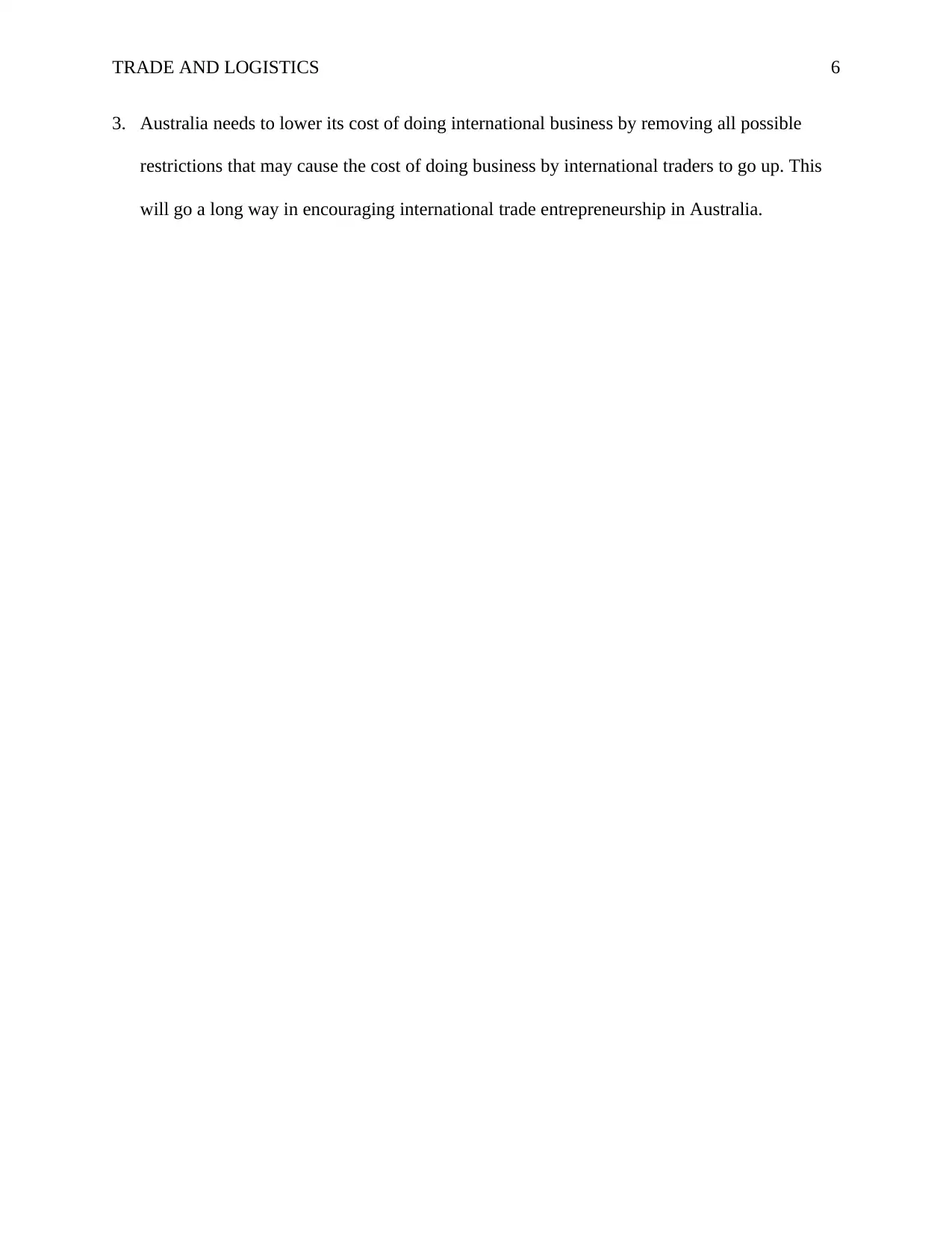
TRADE AND LOGISTICS 6
3. Australia needs to lower its cost of doing international business by removing all possible
restrictions that may cause the cost of doing business by international traders to go up. This
will go a long way in encouraging international trade entrepreneurship in Australia.
3. Australia needs to lower its cost of doing international business by removing all possible
restrictions that may cause the cost of doing business by international traders to go up. This
will go a long way in encouraging international trade entrepreneurship in Australia.
Paraphrase This Document
Need a fresh take? Get an instant paraphrase of this document with our AI Paraphraser
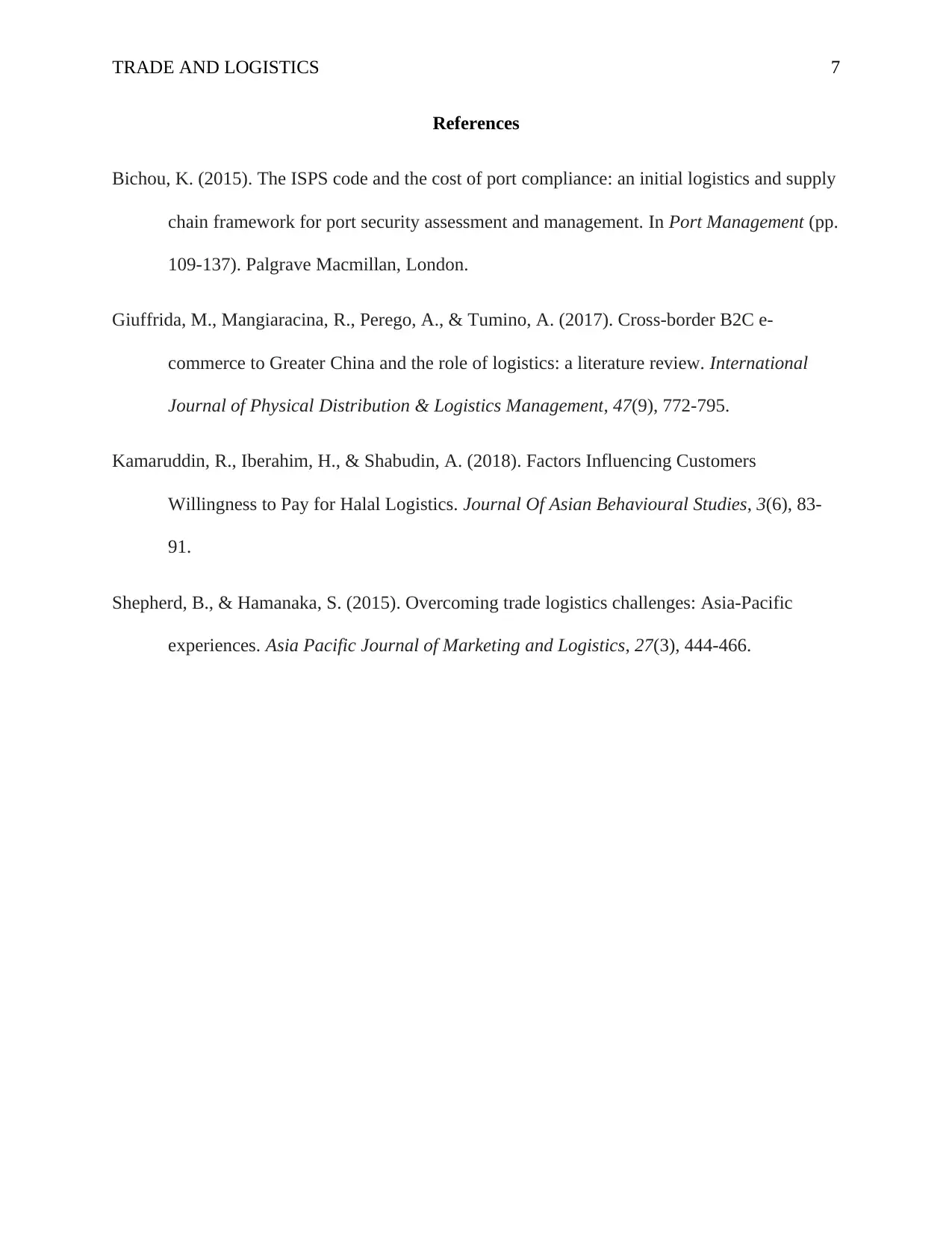
TRADE AND LOGISTICS 7
References
Bichou, K. (2015). The ISPS code and the cost of port compliance: an initial logistics and supply
chain framework for port security assessment and management. In Port Management (pp.
109-137). Palgrave Macmillan, London.
Giuffrida, M., Mangiaracina, R., Perego, A., & Tumino, A. (2017). Cross-border B2C e-
commerce to Greater China and the role of logistics: a literature review. International
Journal of Physical Distribution & Logistics Management, 47(9), 772-795.
Kamaruddin, R., Iberahim, H., & Shabudin, A. (2018). Factors Influencing Customers
Willingness to Pay for Halal Logistics. Journal Of Asian Behavioural Studies, 3(6), 83-
91.
Shepherd, B., & Hamanaka, S. (2015). Overcoming trade logistics challenges: Asia-Pacific
experiences. Asia Pacific Journal of Marketing and Logistics, 27(3), 444-466.
References
Bichou, K. (2015). The ISPS code and the cost of port compliance: an initial logistics and supply
chain framework for port security assessment and management. In Port Management (pp.
109-137). Palgrave Macmillan, London.
Giuffrida, M., Mangiaracina, R., Perego, A., & Tumino, A. (2017). Cross-border B2C e-
commerce to Greater China and the role of logistics: a literature review. International
Journal of Physical Distribution & Logistics Management, 47(9), 772-795.
Kamaruddin, R., Iberahim, H., & Shabudin, A. (2018). Factors Influencing Customers
Willingness to Pay for Halal Logistics. Journal Of Asian Behavioural Studies, 3(6), 83-
91.
Shepherd, B., & Hamanaka, S. (2015). Overcoming trade logistics challenges: Asia-Pacific
experiences. Asia Pacific Journal of Marketing and Logistics, 27(3), 444-466.
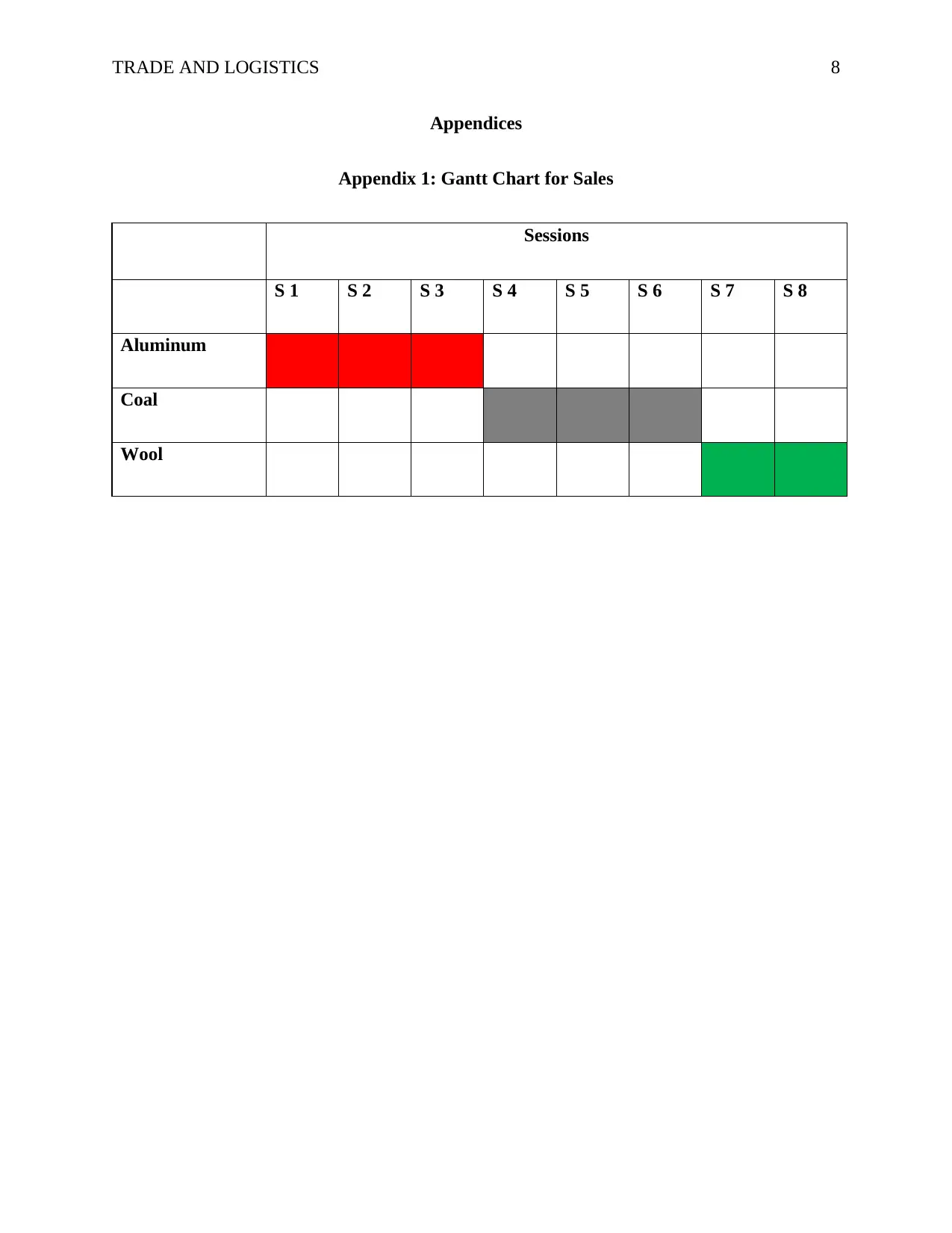
TRADE AND LOGISTICS 8
Appendices
Appendix 1: Gantt Chart for Sales
Sessions
S 1 S 2 S 3 S 4 S 5 S 6 S 7 S 8
Aluminum
Coal
Wool
Appendices
Appendix 1: Gantt Chart for Sales
Sessions
S 1 S 2 S 3 S 4 S 5 S 6 S 7 S 8
Aluminum
Coal
Wool
You're viewing a preview
Unlock full access by subscribing today!
Enjoy unlimited downloads | Full document access |
Advanced AI study tools
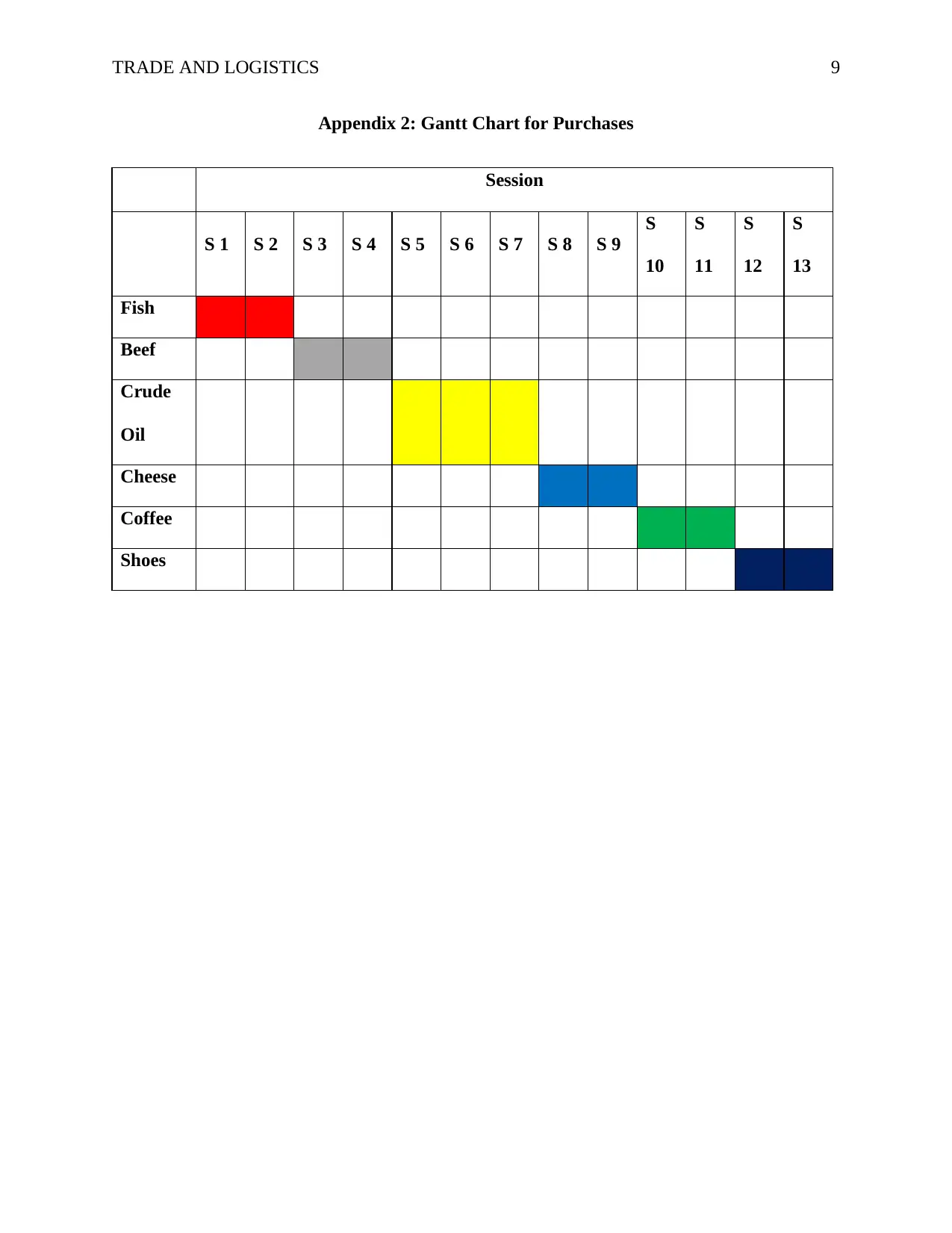
TRADE AND LOGISTICS 9
Appendix 2: Gantt Chart for Purchases
Session
S 1 S 2 S 3 S 4 S 5 S 6 S 7 S 8 S 9
S
10
S
11
S
12
S
13
Fish
Beef
Crude
Oil
Cheese
Coffee
Shoes
Appendix 2: Gantt Chart for Purchases
Session
S 1 S 2 S 3 S 4 S 5 S 6 S 7 S 8 S 9
S
10
S
11
S
12
S
13
Fish
Beef
Crude
Oil
Cheese
Coffee
Shoes
1 out of 13
Related Documents
Your All-in-One AI-Powered Toolkit for Academic Success.
+13062052269
info@desklib.com
Available 24*7 on WhatsApp / Email
![[object Object]](/_next/static/media/star-bottom.7253800d.svg)
Unlock your academic potential
© 2024 | Zucol Services PVT LTD | All rights reserved.





